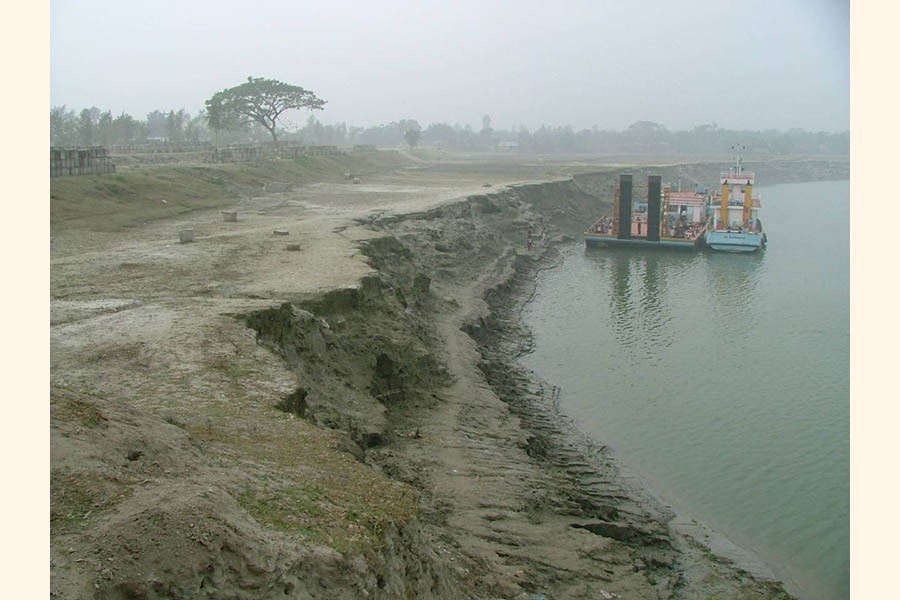
Published :
Updated :

The fearsome mighty Padma of the past has mellowed. Naturally, in its heyday it earned the infamy of all-consuming 'rakshusi' (fiendish) Padma. Today, however, in the lean season the shallow channel of the river at some points in Rajshahi can be easily negotiated on foot. Ferries cannot move between Paturia and Daulatdia directly but have to take round-about routes and that too after continuous dredging. The river simply gasps for breath.
Yet the same river transforms into an irrational demonic force in the monsoon. If the rainfalls are heavier at the foothills of the Himalayan range, the river takes no time to be in spate. Its shrunk channel cannot carry the gushing water coming from the north and huge swathes of land in this deltaic basin have to grapple with floods as a consequence.
Some notable changes probably induced by the climate change have been discernible for the past few years. Rainfall in the monsoon is either scarce or it is quite late. This year, the monsoon rain was negligible but then in what is known as Autumn here, there was more rainfall than in the monsoon. There were floods in some pockets but those were not as widespread as those are supposed to be if such natural phenomena visit the land in the monsoon.
The country may have been spared the calamity of devastating floods but the Padma and other rivers have unleashed their destructive power from another side. They are devouring human settlements from Goalanda of Rajbari to Tongibari of Munshiganj to Kalapara and Baufal under Patuakhali. Thousands of homesteads, markets, schools, mosques, madrasha, temple, gradeyards and other infrastructure have gone under water and more such settlements are threatened. About 1,500 families of Daulatdia and Debogram have lost their homesteads to the devouring Padma. More than a hundred homes and other structures of several villages under Tongibari also went down into the approaching Padma. In the country's south, Tetulia river is wreaking similar havoc. Thousands of people brought out a demonstration at Dhulia launch terminal in Baufal, demanding protection from river erosion.
Lauhajang and Shariatpur also witnessed similar river erosion last year. But it was much earlier than this time of the year. This means the pattern of seasonal change has something to do with rainfalls and their consequences. What is particularly notable is that a much weaker Padma is becoming the source of many people's woes. Floods cause untold sufferings but those are not permanent and with time people can get over the losses suffered. In case of river erosion, people lose home and hearth once for all. If their cultivable lands are also engulfed by a river, they turn pauper and floating people overnight, unless they have land and/or business elsewhere.
However, it is not all a work of Nature. Man's avarice contributes to make the matter worse. There is a complaint that illegal sand extraction through dredging by powerful quarters for commercial purpose in the lean season is mainly responsible for river erosion in Tongibari. Such unplanned dredging left the areas vulnerable to the calamity.
So river erosion is a terrible natural calamity people in this part of the world often suffer. Self-sustained families suddenly find themselves shelterless and without any means of livelihood. Many are forced to flock to cities without enough skill to earn a living. Most of the floating people in the city are such wretched souls. They spend their days in extreme poverty and misery.
What is unacceptable is the fact that the victims of river erosion, whom fate has not been very kind with, also suffer the indifference of the government. There is no clear-cut documentation of these hapless people. When families lose their home and hearth, there is an immediate need for government intervention. Those people must be helped out of the crisis. A project should be framed for their rehabilitation so that they do not have to suffer the ignominy as the city's outcasts.


 For all latest news, follow The Financial Express Google News channel.
For all latest news, follow The Financial Express Google News channel.